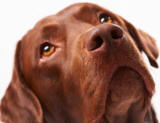
Click on
Library Icon
to learn more
|
Introduction
After puberty, some dogs and
cats begin marking territory inside the house with urine. Although
both males and females mark with urine, intact (unneutered) males
are more likely to do it.
|
It is important to
differentiate marking, which
is a social message, from
waste voiding, which
suggests a lack of
elimination training or a
urinary tract problem.
|
Characteristics
of urine marking
1.
Conservation of urine - voiding small amounts at a time versus
emptying the bladder all at once.
2. Location,
location...urinating on significant locations or
"power spots" such as high traffic areas - near
doors or windows, hallway junctions, or on tall
objects.
3. Urinating on upright
objects.
4. Urinating at times of
agitation or excitement.
5. Urinating near smells
(i.e., pheromones) left by other dogs.
How to Correct
Urine Marking
1. Alter intact males and
females since hormonal influences are one of the drivers for urine
marking.
2. Use a commercial
enzyme-based odor neutralizer (e.g., Liquizyme,
Nature's Miracle, etc.) to remove urine residue from
around doors, windows, or other areas that have been
marked by your dog and/or stray dogs.
NOTE: If the
urine has been marked or sprayed into carpeting, stand on a towel to
"wick" out as much moisture as possible. Then use the commercial
enzyme-based odor neutralizer to saturate the area thoroughly for a
few moments. Remove the excess moisture by standing on a fresh towel
again.
3. Establish clear leadership
using "learn to earn" and leadership exercises.
Review, Leadership
Through Learn to Earn and
Leadership
Exercises.
4. Increase the amount of
exercise for the dog and reduce the amount of times the dog is
allowed to mark.
FOR EXAMPLE: only allow three
or four urine markings during the walk, and continue to walk and not
let the dog stop if he or she attempts to urine mark more.
5. Teach your dog to, "leave it"
when sniffing for a spot to
mark on a walk.
FOR EXAMPLE: when the
dog sniffs a tree or another object he or she generally marks, say,
"Leave it"
and give the dog praise and
a food treat when he or she comes away from the object.
6. Prevent exposure to stimuli
that prompts urine marking.
FOR EXAMPLE: if
the urine marking seems to be related to viewing other dogs out the
window, try to avoid, eliminate, or at least reduce your dog's
awareness of outdoor stressors. This can be achieved by shutting
curtains, blocking windows up to a level that the dog can see out,
translucent window covering to let light and shadows in but not
clear vision, and animal deterrents used for the outdoors (e.g.,
Critter Gitter™, Scarecrow™).
7. Avoid situations that make
your dog anxious over hyper-excited.
FOR EXAMPLE: if
the urine marking is elicited when the dog is denied access to the
owner by a closed door inside the home, confine the dog to an area
where he or she is contented (e.g., a portable dog kennel) before
going behind closed doors.
8. Do not place new upright
objects on the floor until the dog is familiar with
them.
9. If there is some doubt if it
is urine marking vs. waste voiding see your veterinarian for a
complete examination and urinalysis.
NOTE: Rule out
medical causes for the inappropriate elimination.
This will probably involve a urinalysis but discuss
the appropriate course of action with your
veterinarian. If the above indicates that there is
not a medical problem, restart elimination training
as if the dog were a puppy
|